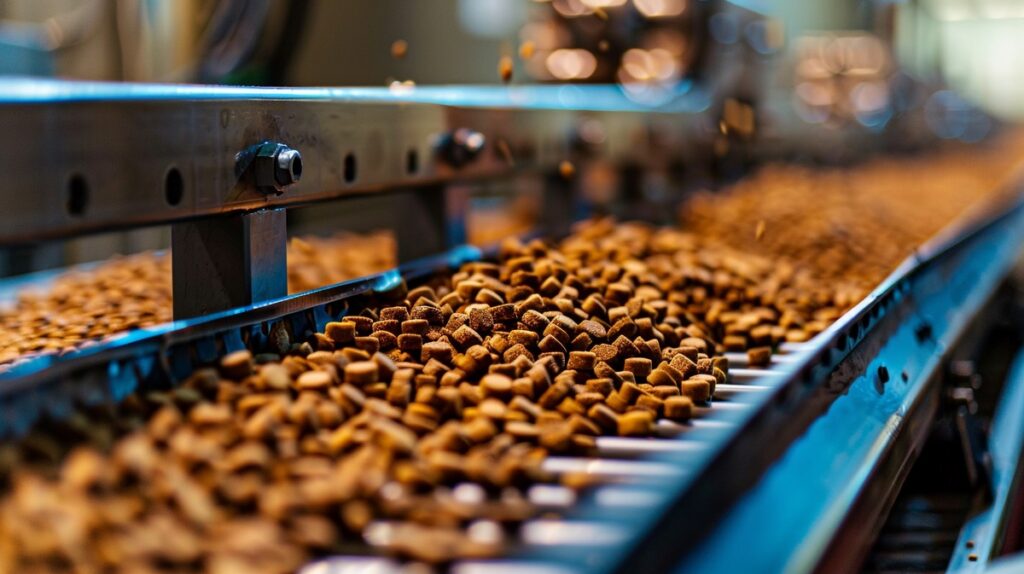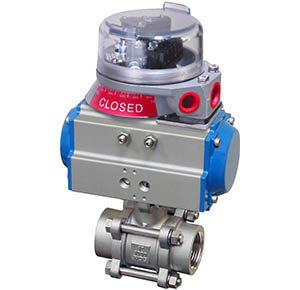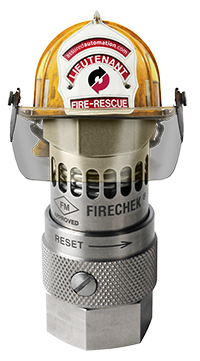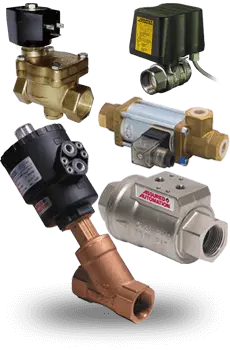
Artificial Intelligence (AI) and robotics are dominating news headlines. Yet manufacturers of food, whether it be for humans or pets, automate their production lines with automated valve assemblies that are driven by PLCs, HMIs, and dedicated computers designed to handle the complex operations of a factory floor. The actuated valve assemblies controlled in this manner can produce large volumes of product rapidly and consistently with every batch.
Imagine making a batch your most popular sauce recipe. You have three ball valves: one for tomato paste, one for water, and one for spices.
- The PLC opens the tomato paste valve.
- A valve position indicator switch confirms the valve is open.
- The PLC receives data from a flow meter to measure the correct amount of paste.
- The PLC closes the tomato paste valve when the desired volume is reached.
- The same process then repeats for water, and then for spices.
- Finally, the mixer motor starts and runs for 5 minutes, to ensure that the ingredients have been thoroughly mixed.
The sauce production is both rapid and foolproof. The key to mass producing a consistent end product is the automation system. Actuated valve assemblies, consisting of actuated valves with position indicating switches that report back to the PLC to confirm the position of the valve (open or closed). The PLC is the brains of the process, telling the actuators when to open and when to close, depending on how much of each ingredient is needed.
Although I would love to have a smaller scale system like this in my kitchen where I can scroll through pages and pages of recipes, automated home food producers are not likely to be on the market any time soon. However, the economics of automated food production is warranted when repeatedly making very large batches of the same recipe, consistently from batch to batch.
For this reason, both human food and pet food manufacturers rely on Assured Automation’s valve-actuator-limit switch assemblies, such as the 38C 2-way assemblies and the 30D 3-way assemblies. The features that make these assemblies well-suited for pet food and human food production include:

- 2-way stainless-steel assembly
38C Series 2-way full port ball valve – 3-piece Body with NPT, Socket Weld, Tri-Clamp, or Butt Weld Connections, 1/2″ to 4″
C series spring return pneumatic actuator – The dual, opposed rack pistons have low friction bearings and guides that provide high-performance, long cycle-life, and fast response.
YO limit switch
This limit switch offers a wide variety of switching & communications. It is easy to adjust with quick set Cams. Its dual shaft O-ring seals eliminate corrosion. And importantly, the limit switch has a long cycle life. It also includes a space saving visual indicator.

- 3-way stainless steel assembly
30D Series sanitary valve features include:- Silicone free valves
- PTFE seats & seals
- ¼”- 4”
- Triclamp end connection
- Valve materials, interior finish, and dimensions comply with 3A, FDA, and USDA requirements.
- Sanitary clamp end connections
- Seats with cavity fillers to avoid media entrapment
- Full port bore
- ISO 5211 direct mount actuator mounting pad
- Blow-out proof stem
- Latch locking handle
- C series spring return actuator
YO limit switch
The pet food manufacturing industry in North America has seen growing adoption of automation and robotics, especially in areas like ingredient handling, mixing, packaging, palletizing, and quality control. The trend aligns with overall food manufacturing automation.
Investments in robotics for packaging and material handling, include automated guided vehicles (AGVs) and robotic palletizers – used primarily for packaging and warehouse logistic.
Investments in automated processing systems including robotic systems for:
- Mixing and batching
- Thermal processing
- Automated loading/unloading
- Robotic bagging machines
And investments in automation technologies for pet food include extrusion and drying systems:
• Automated handling of kibble and wet food
• Robotics for inline quality checks and packaging
• Automated sealers
Why Food Manufacturers Rely on
Assured Automation’s Automated Valve Assemblies
There are many advantages of ordering a complete assembly, straight from Assured Automation’s U.S.-based shop including:
Guaranteed Compatibility
All components are compatible with each other. The valve, actuator, and limit switch are properly sized and matched for optimal performance. You avoid the risk of purchasing components that don’t work well together or require modification to fit.
Simplified Installation
A pre-assembled unit is much easier and faster to install. The actuator and limit switch are already mounted and aligned on the valve, reducing the time and effort required for installation. This can save significant labor costs.
Reduced Risk of Errors
Assembling the components yourself can lead to errors, such as incorrect mounting, wiring, or calibration. A pre-assembled unit eliminates these risks, ensuring that the assembly is done correctly.
Single Point of Contact
If you have any issues with a pre-assembled unit, you only need to contact us for support. This simplifies troubleshooting and warranty claims. If you purchase components separately, you may have to deal with multiple vendors, which can be more complex.
Performance Guarantee
Assured Automation provides a performance guarantee for the entire assembly. This gives you confidence that the unit will perform as expected.
Testing and Calibration
Assured Automation tests and calibrates the complete assembly before shipping. This ensures that the unit is ready to use out of the box and reduces the need for on-site adjustments.
Cost Savings
While the initial cost of a pre-assembled unit may be higher, the overall cost can be lower when considering the savings in installation time, reduced risk of errors, and simplified support.
Customization
Assured Automation can often customize valve assemblies to meet specific application requirements. This can include selecting specific valve types, actuator features, and limit switch options.
Expertise
Assured Automation has expertise in selecting and integrating valve components. We provide valuable advice and support to ensure that you get the right assembly for your application.
Ordering a complete valve assembly from Assured Automation offers convenience, reduces risk, and can potentially save time and money in the long run. It ensures that the components are compatible, properly installed, and tested, and provides a single point of contact for support.
VALVE AUTOMATION
- System Components:
• Stainless Steel Ball Valves: These valves control the flow of fluids (ingredients) in the mixing process. Stainless steel is used for food production due to its corrosion resistance and hygienic properties.
• Actuators: Actuators are devices that automate the opening and closing of the ball valves. Common types include:
» Pneumatic Actuators: Use air pressure to operate the valve.
» Electric Actuators: Use an electric motor to operate the valve.
• Limit Switches: These are sensors that detect the position of the valve (open or closed). They provide feedback to the control system.
• Control System: This could be a Programmable Logic Controller (PLC), a computer, or a dedicated control panel that manages the entire mixing process based on sensor inputs and programmed logic. - Installation:
• Valve Mounting: Install the stainless-steel ball valves in the appropriate locations in your mixing system, ensuring proper sealing and alignment.
• Actuator Mounting: Attach the actuator to the ball valve according to the manufacturer’s instructions. Ensure the actuator is properly sized for the valve.
• Limit Switch Mounting: Mount the limit switches to detect the open and closed positions of the valve. Wire them to the control system.
• Wiring: Connect the actuator and limit switches to the control system. Follow the wiring diagrams provided by the manufacturers. - Programming the Control System:
• Logic Design: Develop the control logic for the mixing process. This will involve defining the sequence of valve openings and closings, mixing times, and other parameters.
• Input/Output (I/O) Configuration: Configure the control system to recognize the signals from the limit switches as inputs and to send control signals to the actuators as outputs.
• Sequencing: Program the control system to execute the mixing sequence. For example:
» Open Valve 1 to add Ingredient A.
» Monitor Limit Switch 1 to confirm Valve 1 is fully open.
» Wait for a specified time to allow Ingredient A to flow into the mixer.
» Close Valve 1.
» Monitor Limit Switch 2 to confirm Valve 1 is fully closed.
» Repeat for other ingredients.
» Start the mixer motor.
» Mix for a specified duration.
» Stop the mixer motor.
» Open Valve 3 to drain the mixture.
• Error Handling: Implement error handling routines to detect and respond to problems such as valve failures or sensor malfunctions. - Calibration and Testing:
- Valve Calibration: Calibrate the actuators to ensure they fully open and close the valves.
- Limit Switch Adjustment: Adjust the limit switches to accurately detect the valve positions.
- System Testing: Test the entire system to verify that the mixing process is running correctly. Monitor the flow rates, mixing times, and other parameters.
- Valve Calibration: Calibrate the actuators to ensure they fully open and close the valves.
- Safety Considerations:
- Emergency Stops: Include emergency stop buttons that can immediately halt the mixing process.
- Interlocks: Implement safety interlocks to prevent the system from operating under unsafe conditions (e.g., if a valve is not fully closed).
- Clean-In-Place (CIP): Design the system to be easily cleaned and sanitized.
- Material Compatibility: Ensure all materials are compatible with the food products being mixed.
- Emergency Stops: Include emergency stop buttons that can immediately halt the mixing process.
- Maintenance:
- Regular Inspection: Inspect the valves, actuators, and limit switches regularly for signs of wear or damage.
- Lubrication: Lubricate the moving parts of the actuators and valves as needed.
- Cleaning: Clean the valves and piping regularly to prevent buildup of food residue.
- Regular Inspection: Inspect the valves, actuators, and limit switches regularly for signs of wear or damage.



